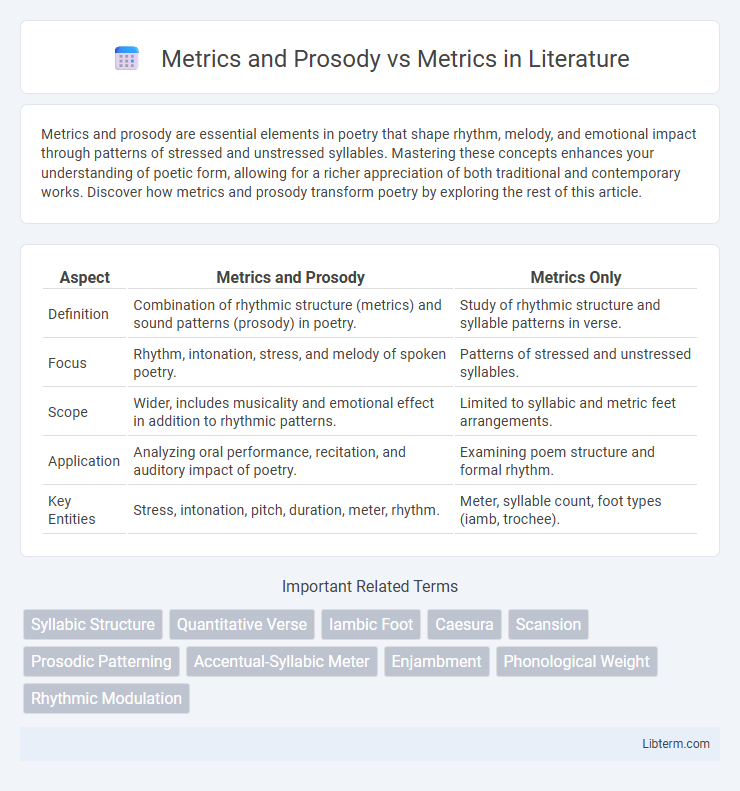Metrics and prosody are essential elements in poetry that shape rhythm, melody, and emotional impact through patterns of stressed and unstressed syllables. Mastering these concepts enhances your understanding of poetic form, allowing for a richer appreciation of both traditional and contemporary works. Discover how metrics and prosody transform poetry by exploring the rest of this article.
Table of Comparison
| Aspect | Metrics and Prosody | Metrics Only |
|---|---|---|
| Definition | Combination of rhythmic structure (metrics) and sound patterns (prosody) in poetry. | Study of rhythmic structure and syllable patterns in verse. |
| Focus | Rhythm, intonation, stress, and melody of spoken poetry. | Patterns of stressed and unstressed syllables. |
| Scope | Wider, includes musicality and emotional effect in addition to rhythmic patterns. | Limited to syllabic and metric feet arrangements. |
| Application | Analyzing oral performance, recitation, and auditory impact of poetry. | Examining poem structure and formal rhythm. |
| Key Entities | Stress, intonation, pitch, duration, meter, rhythm. | Meter, syllable count, foot types (iamb, trochee). |
Understanding Metrics in Poetry
Metrics in poetry refers to the structured pattern of stressed and unstressed syllables that create rhythm and musicality within a verse, essential for the poem's flow and emotional impact. Prosody encompasses the broader study of these patterns, including intonation, stress, and rhythm, offering deeper insight into how metrics shape a poem's meaning and sound. Mastering metrics enables poets and readers to appreciate the intricate balance between form and expression in poetic works.
Defining Prosody: More Than Just Meter
Prosody encompasses the rhythm, stress, and intonation patterns that convey emotion and meaning beyond the mechanical arrangement of metrics in poetry. Unlike metrics which focus primarily on the systematic count of syllables and feet, prosody integrates phonetic elements such as pitch, tempo, and loudness to enhance expressiveness. Understanding prosody requires analyzing how these vocal variations interact to influence the overall acoustic and emotive effect of a verse.
The Relationship Between Metrics and Prosody
Metrics and prosody are intrinsically linked as metrics provides the formal structure of rhythmic patterns in poetry, while prosody encompasses the overall vocal expression, including intonation, stress, and tempo. The relationship between metrics and prosody is essential for understanding how poetic rhythm influences emotional tone and meaning. Accurate use of metrics enhances prosodic features by establishing predictable patterns that guide readers' or listeners' natural speech flow.
Historical Perspectives on Metrics and Prosody
Historical perspectives on metrics and prosody reveal their foundational roles in classical Greek and Latin poetry, where metrics governed syllabic patterns and prosody shaped intonation and rhythm. Ancient scholars like Aristotle and Quintilian analyzed metrical structures to understand poetic harmony and emotional expression. Over centuries, evolving linguistic theories expanded the study of prosody beyond metric patterns to encompass phonetic and phonological dimensions.
Key Components of Metrical Structure
Key components of metrical structure include patterns of stressed and unstressed syllables, which create the rhythm in poetry and speech. Prosody incorporates these metrical elements alongside intonation, pitch, and tempo to convey emotion and meaning beyond the basic meter. Understanding the relationship between metrics and prosody enhances analysis of linguistic and poetic forms by highlighting how rhythmic structures interact with vocal modulation.
Beyond Meter: Elements of Prosody
Beyond meter, elements of prosody encompass pitch, rhythm, tempo, and intonation, which enrich the expressiveness and emotional resonance of poetry or speech. Metrics focus primarily on the structured pattern of stressed and unstressed syllables, serving as the backbone of poetic form. Understanding prosody beyond mere meter enables a deeper appreciation of the nuances in language, revealing how variations in sound and timing influence meaning and aesthetic effect.
Metrics vs Prosody: Core Differences
Metrics primarily focuses on the structured pattern of syllables and stresses in poetry, analyzing formal schemes like meter and rhyme. Prosody extends beyond metrics by encompassing the rhythm, intonation, and emotional tone of spoken or written language, including pitch and tempo variations. The core difference lies in metrics' emphasis on fixed poetic structures, while prosody captures the dynamic auditory features and expressiveness of language.
Analytical Approaches: Metrics-Only vs Full Prosody
Analytical approaches focusing on metrics-only rely primarily on quantitative measures such as syllable count, stress patterns, and rhyme schemes to evaluate poetic structure, offering clear, objective data for rhythm and form analysis. In contrast, full prosody analysis integrates these metrics with qualitative features like intonation, pitch variation, and emotional tone, providing a comprehensive understanding of a poem's auditory and expressive dimensions. Emphasizing metrics alone allows for straightforward computational modeling, while incorporating full prosody captures subtleties essential for nuanced interpretation and performance evaluation.
Effects on Interpretation and Reading
Metrics and prosody significantly influence the interpretation and reading of poetry by shaping rhythm, emphasis, and emotional tone. While metrics provides a structured pattern of stressed and unstressed syllables, prosody incorporates variations in pitch, tempo, and intonation that enhance expressive reading. The combined use of metrics and prosody allows readers to grasp nuanced meanings, highlight thematic elements, and improve overall comprehension during oral and silent reading.
Modern Applications and Debates
Metrics and prosody remain critical in analyzing speech patterns and natural language processing, with modern applications in speech recognition, AI voice synthesis, and automated translation. Recent debates focus on the balance between strict metric rules and the flexible, rhythmic qualities of prosody that enhance naturalness and emotional expression in AI-generated speech. Cutting-edge research explores hybrid models that integrate quantitative metrics with prosodic features to improve human-computer interaction and language learning technologies.
Metrics and Prosody Infographic

 libterm.com
libterm.com